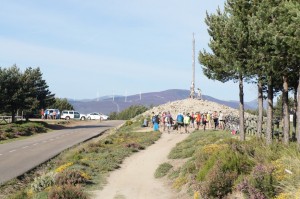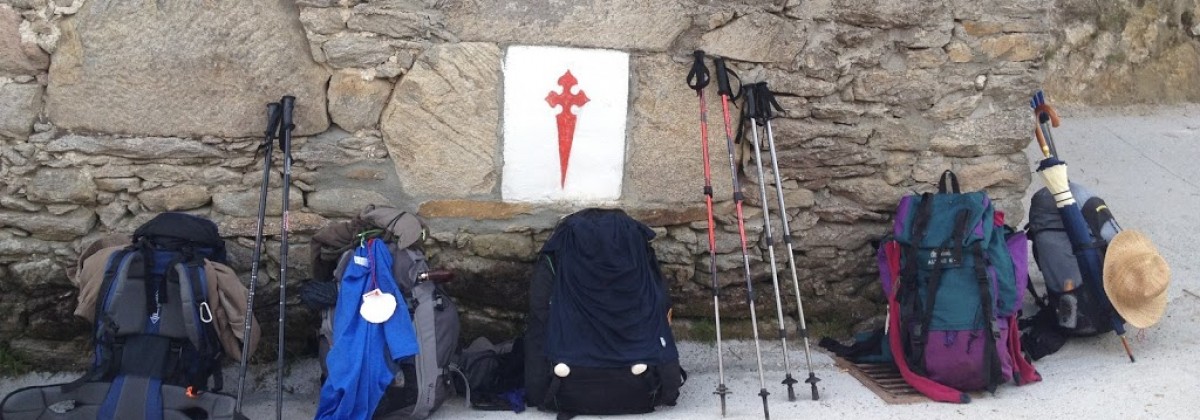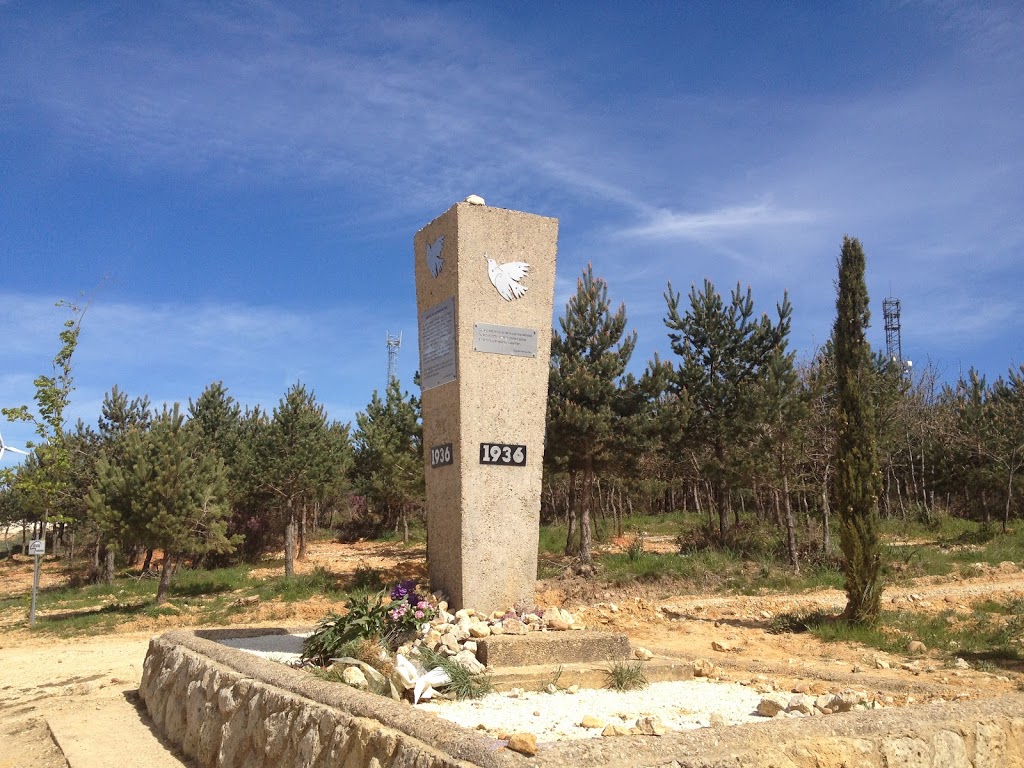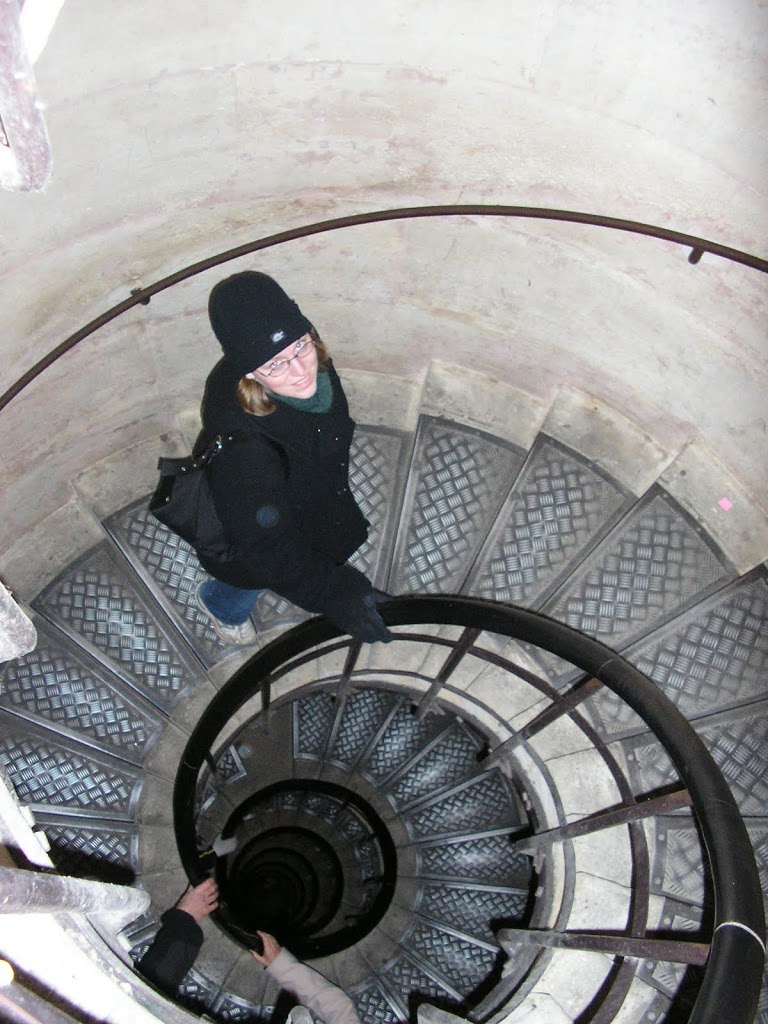the Cruz de Ferro (Iron Cross) marks the highest elevation on the Camino at just over 1,500 meters. it was one of the more iconic images to strike me when watching “The Way” — a cross perched atop a pole above a mound of stones, left behind one by one by peregrinos. as a symbol of the spiritual foundation of the Camino, the potential profundity of our approach to the Cruz was undercut by one of the largest groups of cyclists we’d yet seen.
 while the precise origins of the Cruz de Ferro remain unknown, they might lie in the traditions of any number of inhabitants or visitors, many of whom used stones as markers. the pre-Roman Celts marked passes with cairns; Romans did the same in honor of Mercury, patron saint of travelers. as my book puts it — the hermit Gaucelmo (who built a church in Foncebadón in the 12th century and put the cross on top of the existing cairn) “essentially Christianized a pagan monument.” another theory posits that Galicians traveling eastward to work on farms during the growing season would deposit a stone to mark crossing over the Monte Irago in each direction.
while the precise origins of the Cruz de Ferro remain unknown, they might lie in the traditions of any number of inhabitants or visitors, many of whom used stones as markers. the pre-Roman Celts marked passes with cairns; Romans did the same in honor of Mercury, patron saint of travelers. as my book puts it — the hermit Gaucelmo (who built a church in Foncebadón in the 12th century and put the cross on top of the existing cairn) “essentially Christianized a pagan monument.” another theory posits that Galicians traveling eastward to work on farms during the growing season would deposit a stone to mark crossing over the Monte Irago in each direction.
whatever the origins, however, peregrinos have taken up the tradition of leaving behind stones or other mementos. we’d first encountered the mound in the film, but more than a few people mentioned it early on the Camino; some people bring items with them (there were a couple of printed sheets memorializing individuals, some flags, and other unique items), some people pick up pebbles or rocks along the way. for some these mementos symbolize the sins the hope to absolve by completing the Camino; for some they represent the person for whom they are undertaking the Camino; for some its an acknowledgement of the physical task to which they’ve set themselves. from atop the mound you can see the mountains of Galicia — still another full day’s walk away.
 as I mentioned above, the Cruz de Ferro was one of the more solemn places on the Camino; approaching from a distance after hiking for 25 days and hundreds of miles, anticipating it for weeks and finally seeing it against the clear blue sky… it lends itself to reflection. we arrived along with about 20 cyclists who were quite boisterous and clearly aiming for (and having) a different experience. they certainly weren’t rude or disrespectful, per se, just having a very different experience than most of the peregrinos that arrived on foot. as we entered the final week of the Camino, the differences between cyclist peregrinos and pedestrian peregrinos became more apparent. perhaps it had something to do with knowing that the people you saw today, all kitted out in their spandex with panniers, will reach Santiago in three our four days whereas on foot it will take twice as long or more. and the Camino makes different physical demands on the cyclist versus the pedestrian. there was a woman who arrived on foot a few minutes behind us who was quite upset that the cyclists were taking photos and chatting, generally more boisterous and vocal; she wanted a more somber experience, in addition to a more solemn one, and didn’t take it well that not everyone at the monument a the time felt the same way. but as someone observed, everyone does the Camino in their own way; everyone has their own experience and everyone has their own expectations for what they’ll get out of it. sometimes it’s good to just let the experience wash over you and accept what happens — especially on the Camino. there was almost always an expansive blue sky to bring you back to yourself.
as I mentioned above, the Cruz de Ferro was one of the more solemn places on the Camino; approaching from a distance after hiking for 25 days and hundreds of miles, anticipating it for weeks and finally seeing it against the clear blue sky… it lends itself to reflection. we arrived along with about 20 cyclists who were quite boisterous and clearly aiming for (and having) a different experience. they certainly weren’t rude or disrespectful, per se, just having a very different experience than most of the peregrinos that arrived on foot. as we entered the final week of the Camino, the differences between cyclist peregrinos and pedestrian peregrinos became more apparent. perhaps it had something to do with knowing that the people you saw today, all kitted out in their spandex with panniers, will reach Santiago in three our four days whereas on foot it will take twice as long or more. and the Camino makes different physical demands on the cyclist versus the pedestrian. there was a woman who arrived on foot a few minutes behind us who was quite upset that the cyclists were taking photos and chatting, generally more boisterous and vocal; she wanted a more somber experience, in addition to a more solemn one, and didn’t take it well that not everyone at the monument a the time felt the same way. but as someone observed, everyone does the Camino in their own way; everyone has their own experience and everyone has their own expectations for what they’ll get out of it. sometimes it’s good to just let the experience wash over you and accept what happens — especially on the Camino. there was almost always an expansive blue sky to bring you back to yourself.












